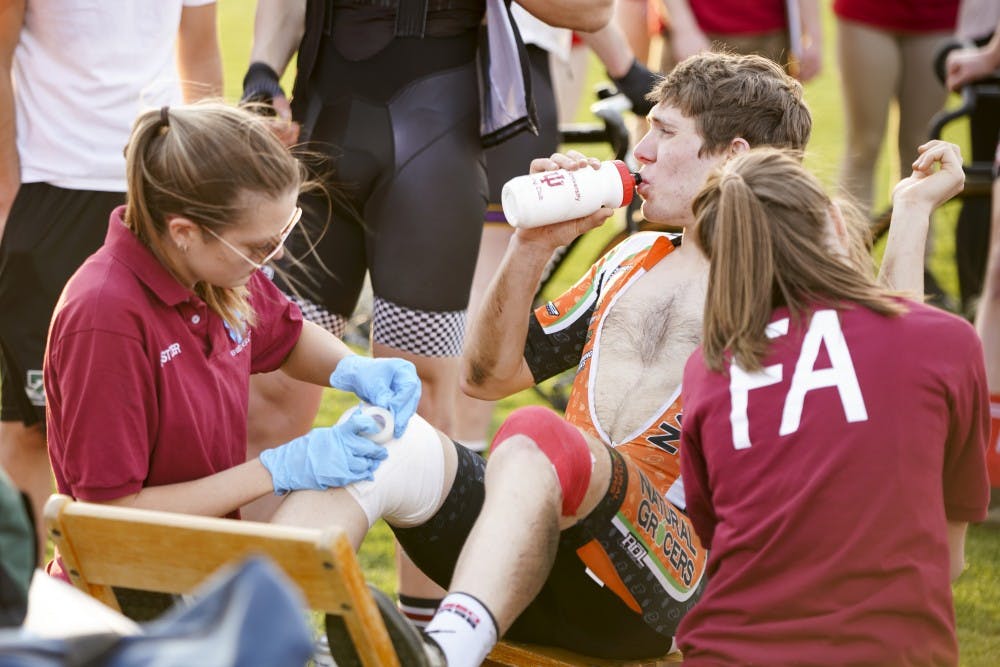With the Little 500 races approaching, all eyes are on the riders.
That’s not to say all eyes haven’t been on the riders in all events leading up to the largest collegiate bike race in the United States. There were Qualifications, Individual Time Trials, Miss N Outs, Team Pursuit and all the practices leading up to the race, every Monday through Friday in-between.
The eyes that pay attention to the riders the closest, however, aren’t the eyes of the fans in the stands. The sets of eyes that are always on the riders are those of Intra Collegiate Emergency Medical Service.
An all-student organization that consists of first aiders and emergency medical technicians.
Unbeknownst to many, without IC-EMS on the scene, these events cannot happen.
The only exceptions to that rule are the Little 500 races themselves, simply due to the fact that it is not in the organization’s contract.
But all the aforementioned events that lead up to Little 500 must have these trained students present to begin.
For the first aiders, the process of being certified begins with CPR and basic life support sessions, which are given by the organization.
As for the EMTs, most become certified by courses provided by IU — SPH-H401: Emergency Med Techn Ambul I and SPH-H404: Emergency Medical Technician Lab. They need at least 160 hours of training, eight hours of clinical shadowing in a hospital setting and eight hours of ambulance ride-alongs. Also, EMTs must pass a state practical, which is a skills test, as well as a written test.
IC-EMS President and senior Pam Muangmingsuk said despite most of the training not being done in real life scenarios, events like these help students apply them to reality.
“Their skills matter,” Muangmingsuk said. “When you’re learning this stuff, it doesn’t always seem real because you are doing it on dummies, but it’s just a better way to see what you’re learning can be applied and can make a difference.”
Muangmingsuk also mentioned it’s cool to see how the riders come to them as a position of authority.
“Not in the sense of like ‘you must obey’ but they look to us to be like ‘what’s wrong,’” Muangmingsuk said. “If you ever go shadow or anything no one is going to ask your opinion, so it’s really cool that they trust us and come up to us.”
It’s students taking care of students.
Junior Laura Watanabe, who rides for Kappa Alpha Theta, knows the members of IC-EMS are at the track and said she feels comfortable knowing if anything happens, they can assist.
Watanabe recalled a time when she fell off her bike and scraped her elbows and knees and immediately went over to the IC-EMS table — located on the field inside the track — where the first aiders took care of her.
The most common injury for riders are ones like Watanabe suffered. Whenever a rider falls on the track, they will most likely get cinders caught in their cuts. If not removed quickly, it can cause infection.
To get out the cinders, IC-EMS uses cinder suds and gauze to cleanly remove them.
Just because the routine injuries consist of taking care of cuts doesn’t mean that’s always the case. Sophomore EMT Ryan Cutshall has seen broken collarbones and several concussions on the track.
“Whenever these bikers get going, they can get up to 20 to 25 miles per hour,” Cutshall said. “If they fall off their bike at that speed and hit their head, it’s going to be a bad day. That’s why we’re here.”
During each shift, it is required to have at least two EMTs and at least one first aider on site, along with a supervisor.
Each shift for the daily practices are around four hours long. Junior Jonathan Mathioudakis is one of the 12 supervisors this year. Riders aren’t going all out every practice, so when those four hours start to become non-eventful, Mathioudakis quizzes the staff on protocols.
He asks them about different things involving cardiac arrests, opening airways on traumatic patients, head-tilt chin lifts, jaw thrusts, chest flail wounds and the list goes on.
“Obviously no one wants to treat anybody,” Mathioudakis said. “But, at the exact same time you have to be ready to treat everything.”
This was the case in last year’s men’s Little 500 race. One of the coaches was run into by a rider during an exchange and he flipped over, hitting his head and biting off part of his tongue. He ended up with a bad concussion and many members of IC-EMS and IU Health were there to tend.
Junior first aider Olivia Elston, who was there for the coach’s fall and was carrying the bag with the equipment in it to tend to him, knows how important it is to be ready for anything.
“Even though in the more extreme situations I can’t do as much to help since I am only a first aider, we still have to be attentive and ready for whatever happens to help our team,” Elston said. “Everyone can contribute even if it’s just having the right equipment for the other members to use.”
Everyone in IC-EMS is ready. That’s what they train for and that’s why they are out there. Mathioudakis said they make sure high-quality patient care is given to every patient.
The riders aren’t IC-EMS's only focus, though. They know how Bloomington gets this time of year. So, especially during the race, their eyes will be moving back-and-forth from the track to the stands in Bill Armstrong Stadium.
IC-EMS is there to tend to anything and anyone, and they are there to make this historic event a safe one.




